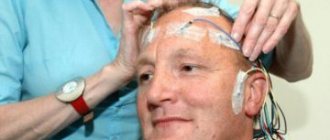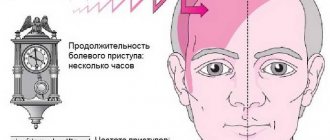Sleep paralysis, or otherwise sleepy stupor, is a condition characterized by the occurrence of temporary paralysis, while the person’s consciousness remains preserved. As a rule, sleep paralysis occurs when waking up or falling asleep. People with sleep paralysis may experience complex hallucinations and intense fear.
This condition occurs in 10-40% of people aged 12 to 30 years, most often in those suffering from narcolepsy. Sleepy stupor is physically harmless, but experiencing it regularly without understanding the essence of what is happening can cause significant psychological trauma.
The neurology clinic of the Yusupov Hospital carries out comprehensive diagnostics, identifying the true causes of sleep paralysis and the diseases that lead to its occurrence.
Scientific background
There are two types of sleep stupor:
- Hypnagogic - when falling asleep.
- Hypnopompic - immediately after waking up.
From a medical point of view, the rationale is as follows: during the REM sleep phase, all motor skills of the body are turned off, only vital organs “work”. This is necessary for safe, calm rest of the brain and body. Switching on occurs when entering the slow-wave sleep stage or upon awakening. Sometimes the brain mediators responsible for these processes malfunction, causing motor skills to either turn on late or turn off earlier than expected. As a result, sleep paralysis occurs.
Is there a connection with genetics?
To establish a predisposition to sleep paralysis at the genetic level, scientists conducted studies with identical twins. It is these twins who “share” almost 100% of their genes with each other (fraternal twins share only 50%).
The experiment showed that there actually is a relationship at the genetic level. A predisposition to sleep stupor occurs in those people who have a mutation in a certain gene responsible for sleep cycles. Official confirmation of the relationship has not yet been provided, and geneticists have a lot of work to do in this direction.
Possible consequences
Sleep paralysis can lead to insomnia - fear of falling asleep.
Many people are interested in “what is dangerous about sleep paralysis?” For most, this syndrome does not pose a particular threat. However, if this phenomenon occurs on an ongoing basis and does not allow the body to fully rest, the following consequences may develop as a result:
- nervous disorder, neurosis;
- formation of phobias;
- panic fear;
- tachycardia;
- labored breathing;
- hallucinations;
- insomnia;
- development of psychopathy.
Consequences often appear for those who become fixated on a sleepy stupor and begin to associate it with the existence of otherworldly forces or the presence of some kind of deviation.
When a state of immobility occurs
There are three stages of sleep:
- Fast phase.
- Slow phase.
- Awakening.
During the fast phase, the brain is highly active, as are the heart muscles, respiratory system and organs of vision. You can observe how a sleeping person's eyes move under closed eyelids. This means that at this moment he is seeing vivid dreams. All other muscles of the body are completely relaxed during this phase. If a person wakes up at this moment, with proper brain function, all the motor mechanisms of the body are simultaneously launched, the muscles become toned.
However, if there are sleep disturbances or failures at the genetic level, paralysis does not go away even after waking up. In most cases, a minute is enough for a person to come to his senses, but even during this short period one can experience real horror and fear.
Sleep paralysis is a unique phenomenon of consciousness. Somnologists conducted tests and found that the brain activity of all participants in the experiment who experienced the anomaly occurred during the REM sleep phase; moreover, the results of the recordings were identical.
Most often, the phenomenon of stupor occurs at the moment of awakening. It has been established that if a person wakes up during REM sleep or immediately after it, stupor occurs. The brain still “sees” colorful dreams, while the body continues to “sleep” and remains motionless. Hence the effect - mystical phenomena, otherworldly shadows seem to a person, a feeling of horror and detachment of the soul from the body arises. In a normal state, awakening occurs at the end of the slow-wave sleep phase, after complete rest of the body, prepared for wakefulness.
Characteristic manifestations
The main symptom of this condition is awareness of what is happening around, but lack of ability to speak or move. Moreover, this phenomenon is observed at the moment of awakening or when falling asleep.
When you experience Old Witch Syndrome, you may experience the following symptoms:
- eye mobility is preserved, for some at this moment they may even be open;
- feeling of tightness in the chest;
- labored breathing;
- feeling of horror;
- the appearance of visual or auditory hallucinations that are accompanied by an emitted threat or danger.
Sleep paralysis - causes
Sleep paralysis is sometimes one of the symptoms of a neurological pathology:
- narcolepsy (spontaneous, unintentional falling asleep);
- somnambulism (walking while sleeping);
- bipolar disorder (psychosis in which manic activity alternates with deep depression).
But most often the phenomenon is spontaneous and occurs on its own due to short-term disorders of the nervous system, in which the stages of the activation of consciousness after sleep and the work of the muscular system are not consistent with each other.
What causes sleep paralysis? There are several provoking factors:
- violation of the daily routine (frequent lack of sleep, short-term but frequent falling asleep during daytime activities);
- constant insomnia at night;
- stress in acute and chronic form;
- long-term use of pills that affect the nervous system (antidepressants);
- harmful habits in a chronic form (nicotine addiction, alcoholism, drug addiction, substance abuse);
- restless legs syndrome;
- the habit of sleeping on your back (it has been proven that sleep paralysis occurs less frequently when sleeping on your side);
- hereditary factors.
Scientists have been studying this phenomenon for a long time and have conducted a lot of research. The result is stunning: 40 out of 100 people experienced sleep paralysis at least once.
Both men and women of all ages are predisposed to the syndrome, but it is more often observed in the age group from 13 to 25 years.
Kinds
Somnologists divide sleep stupor into two types, depending on the time of occurrence:
- Hypnopompic paralysis
This is a natural phenomenon that occurs during the transition from REM sleep to awakening. If during the process of rest the part of the brain that “turns on” consciousness is activated, a person begins to perceive the world around him as during the waking period. At the same time, the part of the brain responsible for muscle activity continues to rest, which leads to temporary paralysis. The duration of this phenomenon ranges from several seconds to several minutes. The hypnopompic type of numbness occurs when waking up naturally, or, for example, when an alarm clock goes off.
- Hypnagogic paralysis
Otherwise, he is called semi-conscious. It occurs during the process of falling asleep in cases where the muscles relax faster than the area of the brain responsible for consciousness can switch off. If a person does not fall asleep in a short time, he will become aware of this state, which will lead to the emergence of strong fear, activating the complete awakening of consciousness while maintaining muscle immobility.
The type of night stupor affects the choice of therapy for treating the disease, so doctors often conduct studies of the patient in the laboratory to recognize all the nuances of the occurrence of sleep paralysis.
Signs and symptoms
Different types of this anomaly have their own symptoms.
Hypnagogic stupor (when falling asleep):
- unexpected sudden awakening during an almost complete transition to sleep, when a person feels as if he fell or someone pushed him;
- feeling of numbness in the body due to fear;
- a depressing feeling as if, along with falling into slumber, the end of life is approaching, death may occur, or there is a feeling of falling into darkness;
- abrupt or complete understanding of what is happening around without the ability to influence it;
- a feeling of absolute awareness of one’s own body (when one feels fingers, hair, bones, things that in ordinary life a person does not pay attention to and takes for granted);
- the awareness that you can move your arm or roll over on your stomach, but the transition from thought to action takes forever;
- the appearance of auditory hallucinations - tinnitus increases, turns into ringing and a kind of monotonous squeaking.
Hypnopompic stupor (after awakening):
- complete immobility of the limbs, inability to open the mouth, utter words or shout;
- a feeling of heaviness in the body, as if someone was leaning on his whole body, making it impossible to move;
- a feeling of the presence of otherworldly mystical creatures, the appearance of which depends on a person’s worldview, his cultural and religious traditions (devils, dead people, vampires - any subconscious fears);
- a feeling of animal horror at the level of primitive instincts (fear of death, suffocation, complete helplessness);
- waking dreams are conscious hallucinations in which a person sees shadows, ghosts, silhouettes of people where they should not be;
- auditory hallucinations accompanied by audible voices, steps, creaks, knocks;
- disorientation in the surrounding world (a person does not understand where he is);
- twitching of nerve endings in fingers and limbs;
- false sense of movement (a person imagines that he has turned over on his back, although in reality he has not moved).
Any of these symptoms force a person to wake up. Due to the sudden emotional surge that has arisen, a person may jerk his hand or moan quietly. This helps to finally get out of sleep paralysis and wake up.
Both types of stupor have several common symptoms:
- difficulty breathing, feeling of suffocation, lack of oxygen, the person seems to have forgotten how to breathe;
- a false feeling that the heart has stopped, then the heartbeat quickens;
- Sometimes blood pressure rises, cold sweat appears, internal trembling appears, accompanied by a feeling of anxiety.
The symptoms are short-term and gradually subside after 1-2 minutes, but it feels like an eternity.
Diagnostics
Sleep paralysis is not a medical diagnosis; in the classification of sleep disorders, it is positioned as a type of parasomnia.
If sleep paralysis occurs only once, there is no need to seek medical help. For frequent episodes, medical intervention is necessary. The doctor will take a medical history based on the events and factors described by the person. Then, if necessary, he will prescribe a special examination that will help identify the causes of frequent sleep paralysis.
The phenomenon may be a symptom of a mental disorder. A more in-depth diagnosis is needed if:
- stupors are repeated and regular, especially if they occur every night or several times during a night’s sleep;
- the symptoms of sleep paralysis are pronounced, with a clear effect on the psyche and nervous system;
- there is a factor of confusion, a constant feeling of fear;
- there are concomitant sleep disorders (nightmares, sleepwalking, tendency to sleep during the day, but insomnia at night);
- Sleep paralysis is accompanied by other symptoms of mental disorders: panic attacks in the daytime, causeless aggression, increased suspiciousness.
To make a correct diagnosis, psychiatrists practice the following methods:
- The patient should constantly keep a diary in which he records each episode of sleep paralysis. Records should be very detailed, describing all sensations and experiences. The doctor himself also makes notes about the presence of other diseases of the nervous system and psyche, which act as risk factors. The diary should be kept from 4 to 6 weeks, if necessary for a longer period.
- Polysomnography is a recording of a patient's sleep using a computer program connected to special equipment. If sleep paralysis is not a pathology of the patient’s psyche in a particular case, polysomnography will show the normal level of sleep.
After an examination, if pronounced signs of parasomnia are identified that bother the patient, he is referred to a specialist who deals with sleep behavior disorders - a somnologist.
Possible complications
The pathogenesis of the attack itself does not pose a threat to human health. But a deterioration in health may occur against the background of the clinical picture itself.
There is a risk of developing complications such as:
- increased blood pressure;
- heart attack;
- airway spasm;
- mental health disorder;
- tachycardia.
In addition, the patient’s general health indicators should also be taken into account: if there is a history of chronic diseases, then such attacks lead to rather complex pathological processes, and death cannot be ruled out.
Treatment
Doctors say that sleep paralysis does not require special treatment and it is impossible to solve the problem only by taking sedative pills. However, specific prevention is required in other aggravating circumstances - neuroses, stress, sleep disturbances with depression, drug addiction, alcohol abuse. All these factors have a cause-and-effect relationship, and paralysis will bother a person until he eliminates them.
By eliminating the accompanying factors, you can achieve normalization of sleep and get rid of periodic sleep paralysis by following simple treatment recommendations:
- Developing the habit of going to bed at the same time.
- Exercise regularly, be active during the day, and be outdoors more often. A healthy lifestyle helps to establish interaction between the brain and muscles, which allows them to work harmoniously during sleep.
- Refusal of bad habits, avoidance of drinking tonic drinks before bed and in the evening, refusal to take pills that cause insomnia.
- Ventilate the room before bed, take relaxing baths and drink relaxing herbal decoctions.
- You need to learn to fall asleep on your side; at first, you can put objects under your back that prevent you from turning onto your back, or you can fall asleep pressed tightly against the wall.
- The number of hours needed for sleep should be established. This indicator is individual - for some, six hours is enough, for others, they don’t get enough sleep even in eight.
Precautionary measures
It is important to learn to cope with stress factors
- It is important that your night's sleep lasts at least eight hours. It is recommended to go to bed no later than 11:00 at night.
- You should try to follow a schedule of going to bed and waking up at a certain time, and not violate it.
- Make sure that your bedroom has a good atmosphere: a ventilated room, optimal air temperature and humidity.
- There is no need to consume caffeinated drinks or alcohol before going to bed. It is also important to remember that meals should be no later than three hours before bedtime.
- Try to keep electronic devices, especially your mobile phone, as far away from your bed as possible.
- It is important to remember the need for constant physical activity, which promotes the production of endorphins.
- Try not to lie on your back when going to bed.
- Protect yourself from stress factors.
Now you know what the phenomenon of sleep paralysis is. It is important to learn how to react correctly to this stupor. And, if this syndrome manifests itself more and more often, then it is worth taking action, contacting a somnologist or neurologist so that a specialist can prescribe adequate therapy.
What to do if sleep paralysis occurs
It is impossible to prevent sleep paralysis once it has already occurred. The half-asleep brain is unable to understand where the dream is and where the reality is. However, anyone can get rid of the syndrome as quickly as possible.
The main thing is to realize that shadows, monsters, witches and devils are hallucinations, they have no mystical background, they are harmless and easily eliminated. Some rules will help stop panic from sleep paralysis.
What not to do:
- There is no need to rush to try to get rid of muscle weakness, try to raise your arm or turn your head. It has been proven that until the brain itself “turns on” the muscles, stupor will only increase the panic fear of helplessness.
- You should not hold your breath, as most people do when they are afraid of something. Stopping the supply of oxygen leads to the accumulation of carbon dioxide in the lungs, which further impedes breathing reflexes.
- But you also don’t need to breathe quickly; hyperventilation (oversaturation of the lungs with oxygen) exacerbates feelings of anxiety and fear.
What should be done:
- try to mentally relax;
- take one deep breath and then breathe evenly, as usual;
- since the muscles of the mouth are also constrained, you need to try to make at least some sound with your mouth closed - hum, moan;
- close your eyes tightly even with your eyes closed;
- at the first signs of muscle activity, begin movements with the tongue, moving it along the gums and palate;
- try to move, first making small movements - move your index finger on your hand, puff out your cheeks, move your feet in different directions;
- Intellectual brain exercise helps: counting from 0 to 10 and back, listing the letters of the alphabet, remembering the past day.
The listed actions help to quickly regain control over your body and eliminate sleep paralysis.
How to relieve the condition
The panic and horror that a person feels during sleep paralysis are emotions experienced at the animal level. It is very difficult to cope with them, since they defy rational explanation. But man, as a rational being, is capable of this. If a symptom recurs, you must adhere to several rules:
- Try to calm down, stabilize your breathing, pausing between inhalation and exhalation for 1-2 seconds.
- There is no need to immediately try to get up - the brain is not able to react so quickly to the awakening of consciousness and, as a defensive reaction, will further weaken muscle tone.
- After your breathing has stabilized, you should try to realize what is happening. Fear comes when a person is in the gap between sleep and reality. If you force your consciousness to work at full strength, you will realize that hallucinations are nothing more than remnants of dreams.
- After the panic subsides, you can try to move your eyes, fingers, or at least your tongue a little. As a rule, partial mobility is preserved, which will help you get rid of the state of helplessness.
- Before you go back to sleep, you need to calm down. You can wash your face, take a shower, or drink warm, soothing tea.
When a disease occurs in one of the spouses, you need to warn your partner about this and ask to wake him up or calm him down if he notices an attack. Observation of patients has shown that emotions are clearly reflected on the face, so it is not difficult to understand that a person is terrified.











